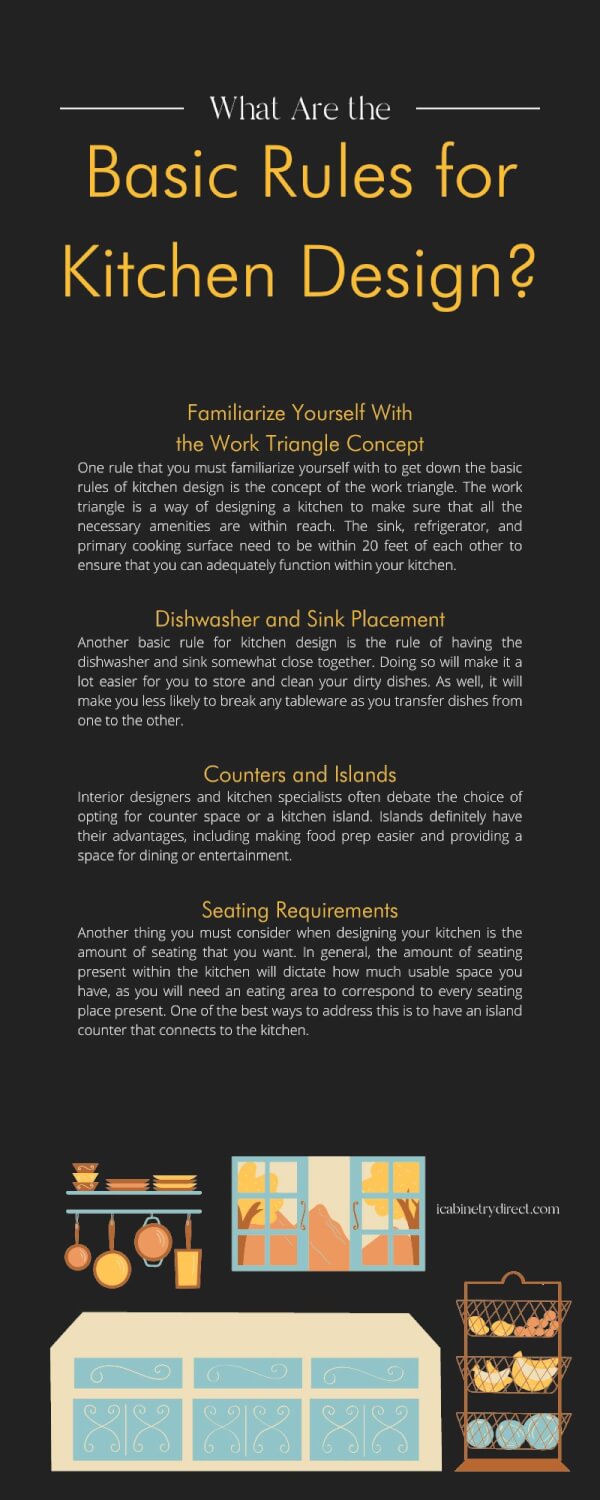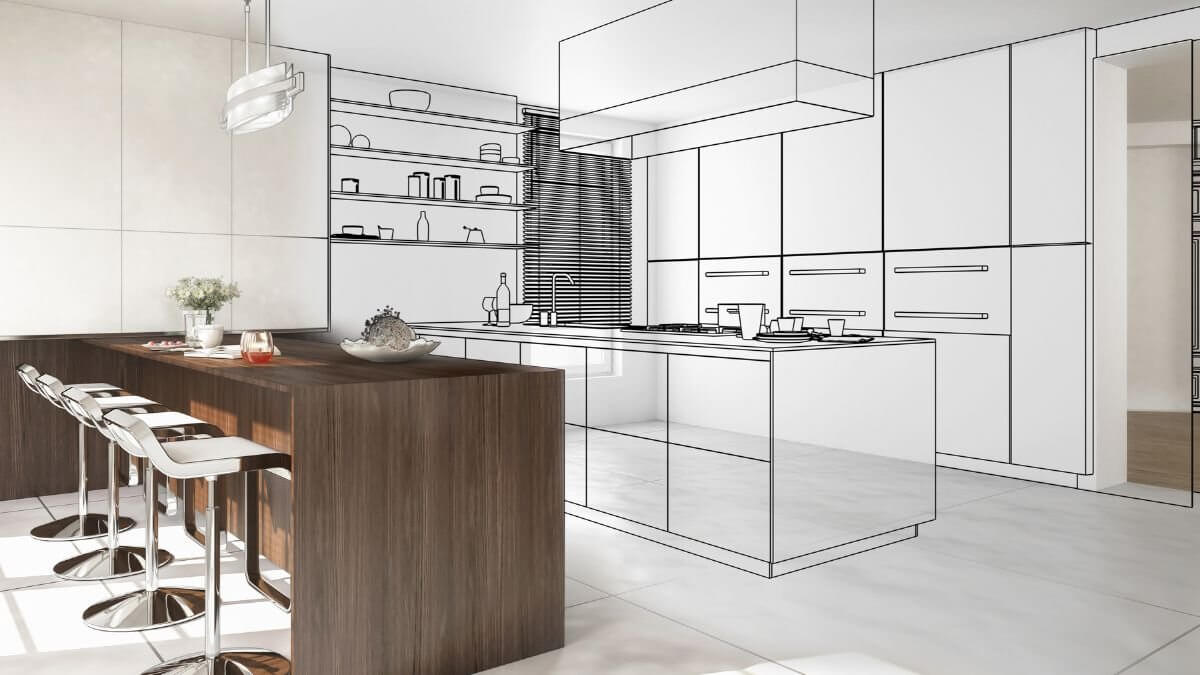A true dream kitchen is beautiful, functional, and comfortable. Crafting this balance can be quite difficult, which is why professional kitchen designers are so helpful. However, there are a few basic rules that apply to all kitchen sizes and styles, from a small L-shaped kitchen layout to a large open-concept home. Today, we’ll answer the question, “What are the basic rules for kitchen design?” in a comprehensive guide you can use to maximize space and optimize comfort.
Familiarize Yourself With the Work Triangle Concept
The kitchen work triangle is the space between the stove, sink, and refrigerator, which are the three main work areas of a kitchen. By keeping these work zones within around 9 feet of each other, you ensure easy access to everything you need and can work more efficiently.
This principle stands true no matter what kitchen layout design you have. For example, if you have a U-shaped kitchen, you might place the stove on the short arm of the U, then have the kitchen and sink on the two parallel walls.
Placing tall cabinets beside the fridge lets you quickly access canned goods, while countertop space between the sink and stove allows you to stack the pans to wash right after you’re done cooking.
These principles work well for a one-cook kitchen, but they can also impede traffic flow if multiple family members need cooking space. Modern kitchen designers often adapt this principle for larger kitchens by adding a kitchen island or developing distinct zones for different cooking tasks. This allows multiple cooks to work efficiently.
Dishwasher and Sink Placement
An ergonomic setup with your sink and dishwasher makes it easier to load dishes after rinsing; it also improves the symmetry of your kitchen, making it look balanced.
In general, you should aim for 18 to 24 inches of countertop space between your sink and dishwasher.
Counters and Islands
A kitchen island is where form meets function. It can be an additional prep zone, serve as more storage for items like small appliances, or become a convenient breakfast spot.
Kitchen islands typically come in two ideal heights: 36 inches and 42 inches. A 36-inch high island is the same height as the typical countertop, while a 42-inch island is a bar-style island, usually complemented with barstools.
The minimum depth for an island overhang is 12 inches, though it may have as little as 1 inch if you don’t intend to use it for seating. A 15-inch overhang is considered ideal for knee space. 18 inches is ideal if you have a bar-style island, as bar stools can be fully tucked under to avoid injuries.
Many choose to match their kitchen island top to their countertops and wall cabinets for visual cohesion, but you can also contrast. For example, if your upper cabinets are white and base cabinets are black, consider reversing this for the island to help it stand out.
Whether you choose a kitchen island or additional storage in perimeter cabinets depends on your kitchen layout, counter space needs, and workflow. An island may be impractical in a one-wall kitchen, but it could offer a greater sense of flow and visually anchor the space in an open-concept kitchen.
Seating Requirements
Kitchen seating can be a great way to bring family together while maximizing space. You will generally need between 24 and 30 inches per person. To balance seating and circulation, ensure there is about 42 to 44 inches between a seated person and the wall, so people can pass easily without feeling cramped. If anyone in your family uses a wheelchair, you’ll need around 60 inches.
You’ll also need to decide between bar seating, such as around a kitchen island, and a breakfast nook. A breakfast nook will be a better option for families with young children to prevent injuries from a chair falling over. On the other hand, bar seating around an island can be a space-saving option because it doubles as an additional prep zone and maximizes storage.
Any dining area should have proper lighting. If your home doesn’t have a lot of natural light, consider installing task lighting above the bar or breakfast nook.
Safety Rules
When designing your new kitchen, safety should be your primary concern. Most building codes require you to have at least one operable window in every room so that you can prevent asphyxiation.
Cooking surfaces, like ovens and stoves, should be kept 9-12 inches away from corner cabinets to avoid accidental fires. Also consider the vertical space between upper cabinets or the ceiling and cooktop surfaces to avoid them catching fire. Designate a storage area for emergency supplies, such as a fire extinguisher and first-aid kit.
Child safety is also key. Don’t keep cleaning supplies on open shelving; instead, keep them all in a single cabinet with a child-safety lock. Use rounded corners on doors and countertops to prevent active children from hurting themselves on sharp edges.
Ensure Everything Matches
A harmonious kitchen layout will be both eye-catching and visually consistent. When ordering your cabinets, ensure that the cabinet depth is the same on all base or upper cabinets. If you need a different cabinet width for vertical storage in one corner, such as a side pantry, keep the depth the same.
Choose complementary colors and finishes for your walls and cabinets. For example, you might choose soft neutral paint with wood tone for a timeless but elegant look.
If you’ve gone with the contrast wall concept, where a single wall is painted a different color, then you’ll want to choose a more neutral cabinet finish that won’t clash with either paint color.
The two-tone look is very popular right now. In many cases, this involves different colors or finishes for the uppers and lowers, or choosing a different finish for the kitchen island and perimeter cabinets. However, use the same hardware finish to visually connect these different areas.
iCabinetry makes it easy to coordinate your cabinets. We offer a wide range of cabinetry in various sizes, styles, and finishes, ensuring everyone can find what they’re looking for.
The Importance of Kitchen Layout Planning
Planning the right layout is the key to a highly functional kitchen. Rather than selecting a kitchen layout design to fit the cabinetry, you need to arrange the cabinets around your chosen layout. These are the most common layout types and their benefits.
- L-Shaped Kitchens: Best for small and medium kitchens, an L-shape kitchen offers maximum storage and creates an efficient work triangle. To get the most benefit, consider space-saving measures like Lazy Susans.
- U-Shaped Kitchens: One primary benefit of a U-shaped kitchen is that it minimizes foot traffic while allowing multiple cooks to work in the space. There is also plenty of counter space, and you can also add an island for an eating area.
- Galley Kitchens: A galley kitchen is a long, narrow kitchen with a single row of counters and appliances. This is a good option for a small kitchen, as everything is within reach, but it generally means you can only have a single cook at a time.
- Peninsula Kitchens: The peninsula kitchen has an additional counter that comes out from the wall. This serves as a natural divider to the room and is often used to create a breakfast nook.
- Open-Concept Kitchens: Open-concept kitchens are a good choice if you have multiple chefs, as there’s more room to move around. However, it’s crucial that you still consider the work triangle concept and create separate work areas for different cooks.
Balancing Aesthetics and Functionality
A kitchen isn’t just a showpiece; it’s an efficient workspace for making delicious meals. As such, it is crucial to balance aesthetics with functional elements.
Durable and stylish cabinets make your daily work easier while adding a touch of beauty. For busy families, consider laminate or veneer slab doors and drawer fronts, which are beautiful and easy to clean.
Integrated appliances reduce frustration while making meals. For example, consider placing your microwave in open shelving above the oven so that it’s easy to melt butter for your dish without reaching.
Hidden storage provides a clean aesthetic and keeps everything easy to access. One common option is a tilt-out drawer for your trash can, making it simple to toss in food wrappers. Pull-out shelving and Lazy Susans allow you to make the most of your space.
iCabinetry’s designers have curated selections that maximize efficiency while maintaining beauty. Contact us to discuss your specific needs so we can customize your new cabinetry to your unique lifestyle.
Common Kitchen Design Mistakes to Avoid
Making the perfect kitchen requires careful thought and planning. Unfortunately, it’s easy to make mistakes that can significantly reduce your kitchen’s beauty and functionality, including these common issues.
- Poor Lighting: Consider installing lights for different zones, such as track lighting above the sink, to illuminate various areas as needed.
- Ignoring Traffic Flow: Ignoring the work triangle or failing to consider how people will move around each other while working can lead to constant frustration as cooks try to get their work done. An experienced designer can help you decide how much space you need.
- Inadequate Storage: If you don’t have enough storage or use it inefficiently, your kitchen will feel cluttered. Integrated storage solutions keep everything in its place so you can find what you need right when you need it.
- Mismatched Colors: Unfortunately, many people fail to consider other design elements, such as flooring and countertops, when choosing their colors. Ensure you keep these in mind while shopping to create a more harmonious look.
- Overcrowded Islands: An overly large island can impede workflow and make the room feel too small. Work with a designer to find the right ratio for your needs.
Final Thoughts
By considering these basic design rules, you can create a highly functional and stunning space. iCabinetry’s modern kitchen cabinetry collections can help you capture all of these principles, ensuring that you fall in love with your kitchen again.

FAQs about the Basic Rules of Kitchen Design
The most important rule is the kitchen work triangle, which explains that you should not have more than 4 to 9 feet between each point of the triangle: the stove, fridge, and sink.
Maximize vertical space, use a light palette to visually open it, and employ the work triangle principle to ensure a good workflow.
Standard kitchen counter height is 36” high and 25-26” deep. Islands are generally 36-42” high and 30-36” deep.
Use the same hardware for all cabinets, upgrade your fixtures, and refinish your cabinets to brighten up the space on a smaller budget.
Use rounded corners on countertops to prevent injuries for children, and ensure there is adequate space around appliances to avoid fires.




